TasunkaWitko
Well-Known Member
Beet Kvass
I have been looking into beet kvass, which is apparently a variation on traditional kvass that is normally made from rye bread. In this case, the juice from lacto-fermented beets is used, instead. I don't know much about it yet, but various internet sources say that it is a traditional thing in Russia and the surrounding regions. My own research indicates that it is made in Lithuania, where it is called gira; having said that, I would be surprised if it wasn't known in Russia, Ukraine and other nearby countries, as well.
This looks incredibly easy to make, and by all descriptions it is both tasty and very healthy. Some recipes that I have found use a "starter culture" of whey or naturally-fermented sauerkraut juice, yet others do not; I think the culture simply gets the process started more quickly, but am not totally sure. One recipe even has you add some onion and cabbage to tone down the "beety" taste; another adds ginger for an interesting kick.
There is surely a use for the beets once they are fermented, as well, but having absolutely no experience with this yet, I cannot say for sure what that could be, other than simply eating them by themselves or possibly as part of a salad.
https://www.culturesforhealth.com/learn/recipe/lacto-fermentation-recipes/beet-kvass/
http://nourishedkitchen.com/beet-kvass-recipe/
http://holisticsquid.com/beet-kvass-myth-busting/
https://wellnessmama.com/9087/beet-kvass/
https://www.homemademommy.net/2013/08/how-to-make-beet-kvass-that-actually-tastes-good.html
https://www.mommypotamus.com/beet-kvass-recipe/
https://en.wikipedia.org/wiki/Kvass
(fast forward a few days)
On Saturday, 17 February, I was able to get this project going. As I was gathering my ingredients and equipment, I got a call from my dad asking me to come out and assist him with a couple of things, so I brought my project out there in order to show him what I was up to. He took a pretty good interest in it, as I had recently purchased one of FarmtSeady's Fermented Vegetable Kits for him, as well:
http://farmsteady.com/shop/fermented-vegetable-kit
This kit is identical to their "Kraut Kit," which I have, and I am assuming that the latter will eventually be phased out in order to highlight the versatility of the former, which of course can also make sauerkraut just as easily; in fact, my dad had already just finished making his first batch of sauerkraut, which he pronounced to be most excellent.
The process for Beet Kvass is very, very easy, which means that - in my opinion - there really is no good reason not to try this, if you have even the slightest interest. Basically, I followed the instructions for the general fermenting of vegetables as described on FarmSteady's website:
http://farmsteady.com/fermented-vegetables/
I also incorporated much of the information that I learned in my reading, following the sources listed above.
I usually open with a photo of everything needed, so here you go:
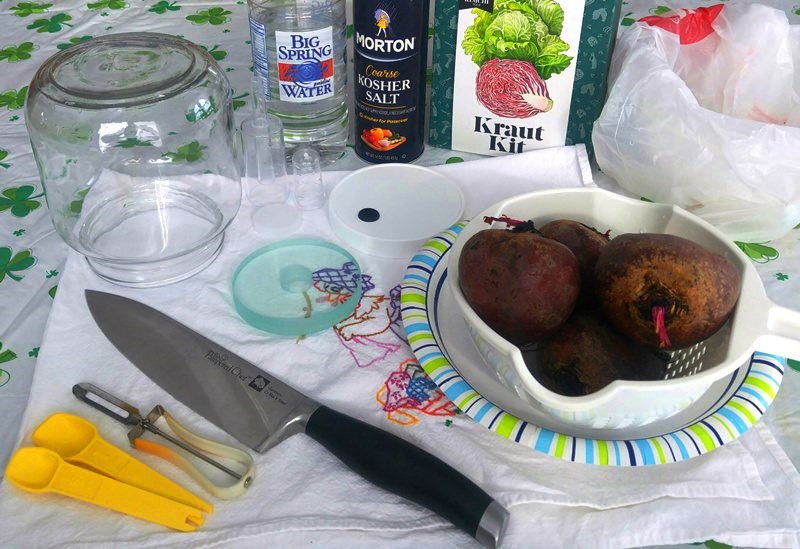
Everything here is self-explanatory, of course; 4 beets - cut into cubes - seemed to work perfectly for filling this fermentation jar. The only other thing I'll note is that my mother's tablespoon-sized measuring spoon, which has been in our family since the 1970s, has been a bit warped and partially-melted on one side since the 1980s. This may or may not have been my fault; I can't remember. In any case, It is probably still accurate, or at least "close enough," but I decided to just use the teaspoon to do my measuring. I don't know why I also included the half-teaspoon, but there it is.
Getting started, I dissolved 2 tablespoons of Kosher salt into 1 quart of spring water that I had warmed a bit in the microwave:
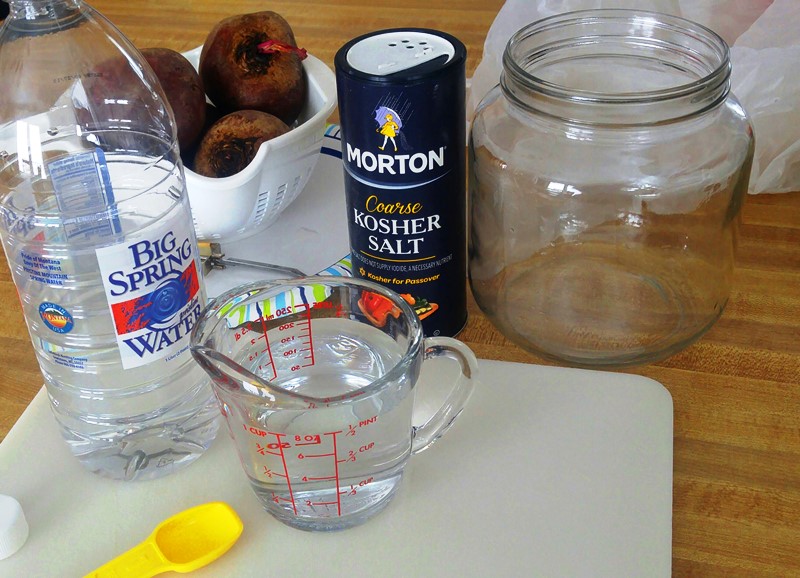
Obviously, other non-iodised salt such as canning or sea salt can be used; however, because of the different densities that different salts have, I do not at this time know what proportions should be used for those salts. Sooner or later, I will find out and will post about it.
Once that was done, I cut off the tops and bottoms of the beets:
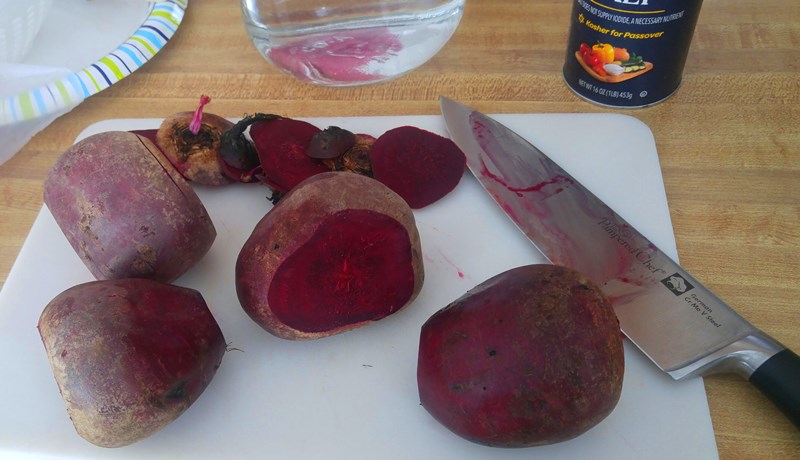
Most sources say that this is not necessary; indeed, some sources even say that you should not even scrub or peel the beets, just rinse them and ensure that the dirt is removed from them. The reason for this is that the microbes on the peels will aid in the fermentation; however, other recipes say to peel them, so I proceeded to do so:
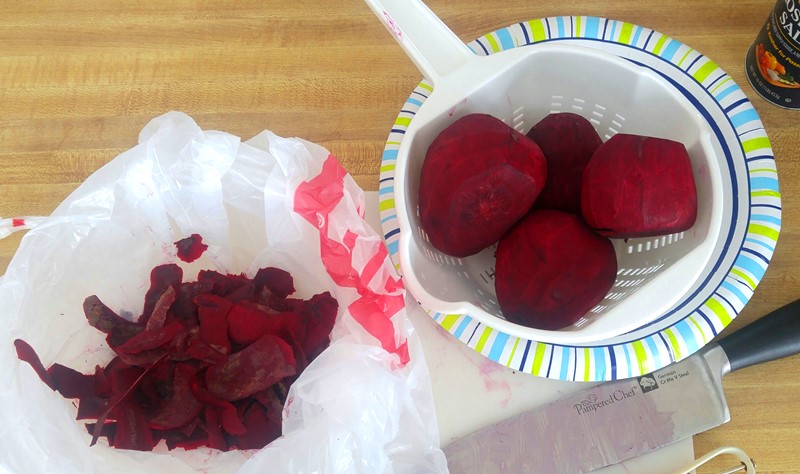
Next, I chopped them into cubes that were a "medium" size:
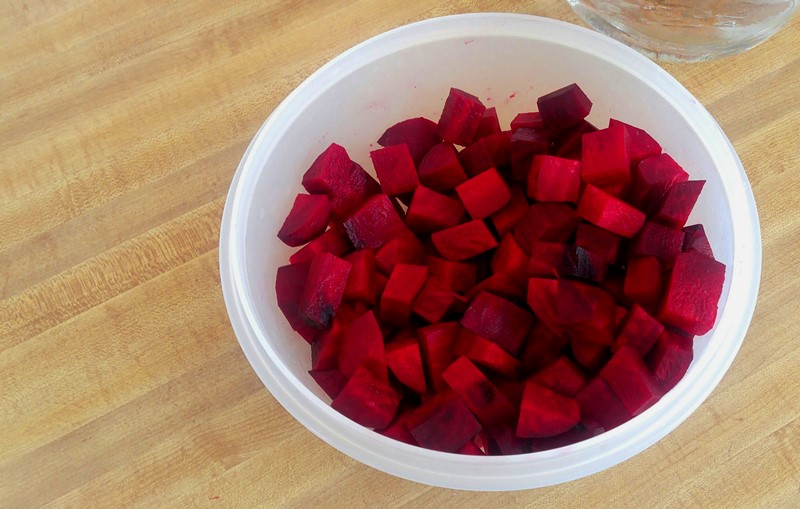
I considered slicing them into "chips," but ultimately chose not to.
After that, I carefully dropped them into the brine and weighed them down with the fermentation weight, in order to keep them below the surface of the brine:
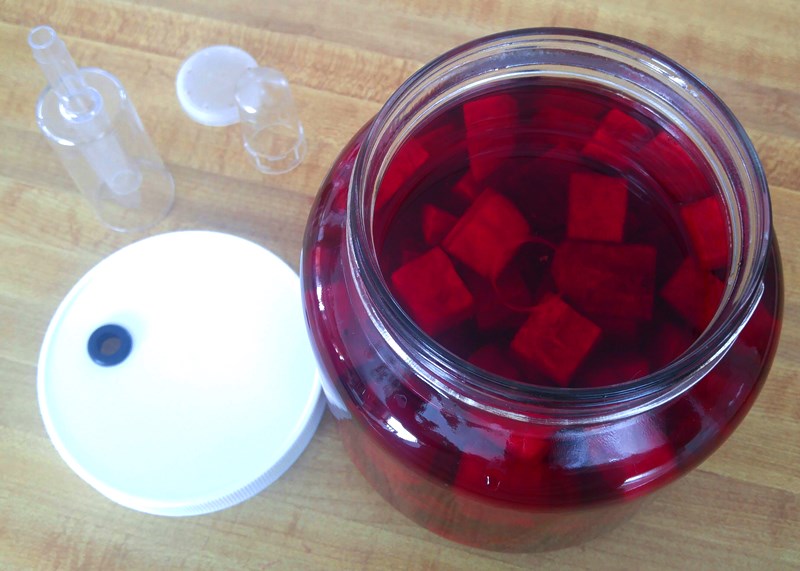
One or two of the cubes escaped, and I pushed them back down under the weight. This is where slicing them into chips might have been handy so that they would be easier to keep beneath the weight; however, I do not know if there would have been any negative effects to doing so.
Finally, I put the lid on and attached the airlock:
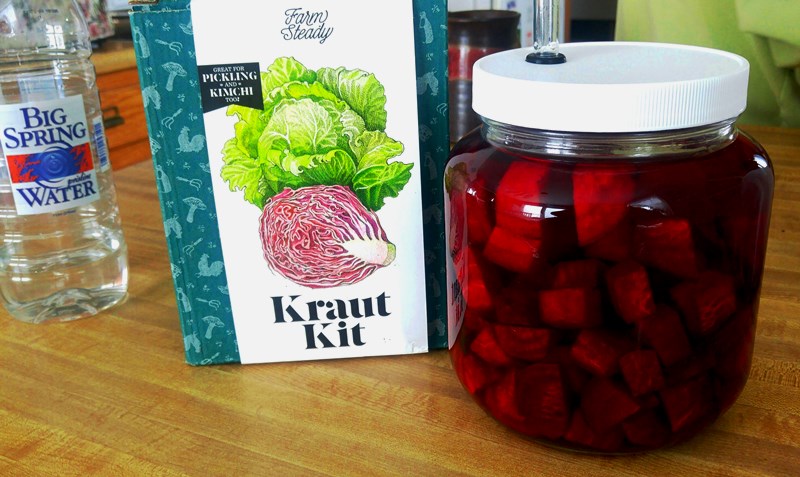
As you can see, the water was already starting to turn a deep, beautiful red.
That's all there is to it!
Once I was finished helping my dad, I carefully transported the beets back home and put them on the top shelf of our bedroom closet, where the temperatures are fairly stable and in the 60- to 70-degree range that is advised for good fermentation.
As for how long the kvass should ferment, the sources vary. If using whey or some other "starter," some sources advise 2 to 4 days; other sources, with no starter, say that fermentation times can range from "at least a week" to 2 weeks. FarmSteady, in their general instructions for fermenting vegetables, prescribes "5 to 7 days." Nearly all sources add the caveat "...or until desired flavour is reached." With all of this in mind, I'll check my kvass after a week, and go from there. My experience with lacto-fermenting so far has taught me that, for whatever reason, things take a little longer than the "recipes" say that they will, so I am going to guess that this will take 2 weeks at a minimum; having said that, all we are after here is the fermented juice, not so much the vegetables themselves, so we shall see.
In any case, that's what I have for now; more as it happens, etc. &c....
Ron
I have been looking into beet kvass, which is apparently a variation on traditional kvass that is normally made from rye bread. In this case, the juice from lacto-fermented beets is used, instead. I don't know much about it yet, but various internet sources say that it is a traditional thing in Russia and the surrounding regions. My own research indicates that it is made in Lithuania, where it is called gira; having said that, I would be surprised if it wasn't known in Russia, Ukraine and other nearby countries, as well.
This looks incredibly easy to make, and by all descriptions it is both tasty and very healthy. Some recipes that I have found use a "starter culture" of whey or naturally-fermented sauerkraut juice, yet others do not; I think the culture simply gets the process started more quickly, but am not totally sure. One recipe even has you add some onion and cabbage to tone down the "beety" taste; another adds ginger for an interesting kick.
There is surely a use for the beets once they are fermented, as well, but having absolutely no experience with this yet, I cannot say for sure what that could be, other than simply eating them by themselves or possibly as part of a salad.
https://www.culturesforhealth.com/learn/recipe/lacto-fermentation-recipes/beet-kvass/
http://nourishedkitchen.com/beet-kvass-recipe/
http://holisticsquid.com/beet-kvass-myth-busting/
https://wellnessmama.com/9087/beet-kvass/
https://www.homemademommy.net/2013/08/how-to-make-beet-kvass-that-actually-tastes-good.html
https://www.mommypotamus.com/beet-kvass-recipe/
https://en.wikipedia.org/wiki/Kvass
(fast forward a few days)
On Saturday, 17 February, I was able to get this project going. As I was gathering my ingredients and equipment, I got a call from my dad asking me to come out and assist him with a couple of things, so I brought my project out there in order to show him what I was up to. He took a pretty good interest in it, as I had recently purchased one of FarmtSeady's Fermented Vegetable Kits for him, as well:
http://farmsteady.com/shop/fermented-vegetable-kit
This kit is identical to their "Kraut Kit," which I have, and I am assuming that the latter will eventually be phased out in order to highlight the versatility of the former, which of course can also make sauerkraut just as easily; in fact, my dad had already just finished making his first batch of sauerkraut, which he pronounced to be most excellent.
The process for Beet Kvass is very, very easy, which means that - in my opinion - there really is no good reason not to try this, if you have even the slightest interest. Basically, I followed the instructions for the general fermenting of vegetables as described on FarmSteady's website:
http://farmsteady.com/fermented-vegetables/
I also incorporated much of the information that I learned in my reading, following the sources listed above.
I usually open with a photo of everything needed, so here you go:

Everything here is self-explanatory, of course; 4 beets - cut into cubes - seemed to work perfectly for filling this fermentation jar. The only other thing I'll note is that my mother's tablespoon-sized measuring spoon, which has been in our family since the 1970s, has been a bit warped and partially-melted on one side since the 1980s. This may or may not have been my fault; I can't remember. In any case, It is probably still accurate, or at least "close enough," but I decided to just use the teaspoon to do my measuring. I don't know why I also included the half-teaspoon, but there it is.
Getting started, I dissolved 2 tablespoons of Kosher salt into 1 quart of spring water that I had warmed a bit in the microwave:

Obviously, other non-iodised salt such as canning or sea salt can be used; however, because of the different densities that different salts have, I do not at this time know what proportions should be used for those salts. Sooner or later, I will find out and will post about it.
Once that was done, I cut off the tops and bottoms of the beets:

Most sources say that this is not necessary; indeed, some sources even say that you should not even scrub or peel the beets, just rinse them and ensure that the dirt is removed from them. The reason for this is that the microbes on the peels will aid in the fermentation; however, other recipes say to peel them, so I proceeded to do so:

Next, I chopped them into cubes that were a "medium" size:

I considered slicing them into "chips," but ultimately chose not to.
After that, I carefully dropped them into the brine and weighed them down with the fermentation weight, in order to keep them below the surface of the brine:

One or two of the cubes escaped, and I pushed them back down under the weight. This is where slicing them into chips might have been handy so that they would be easier to keep beneath the weight; however, I do not know if there would have been any negative effects to doing so.
Finally, I put the lid on and attached the airlock:

As you can see, the water was already starting to turn a deep, beautiful red.
That's all there is to it!
Once I was finished helping my dad, I carefully transported the beets back home and put them on the top shelf of our bedroom closet, where the temperatures are fairly stable and in the 60- to 70-degree range that is advised for good fermentation.
As for how long the kvass should ferment, the sources vary. If using whey or some other "starter," some sources advise 2 to 4 days; other sources, with no starter, say that fermentation times can range from "at least a week" to 2 weeks. FarmSteady, in their general instructions for fermenting vegetables, prescribes "5 to 7 days." Nearly all sources add the caveat "...or until desired flavour is reached." With all of this in mind, I'll check my kvass after a week, and go from there. My experience with lacto-fermenting so far has taught me that, for whatever reason, things take a little longer than the "recipes" say that they will, so I am going to guess that this will take 2 weeks at a minimum; having said that, all we are after here is the fermented juice, not so much the vegetables themselves, so we shall see.
In any case, that's what I have for now; more as it happens, etc. &c....
Ron


